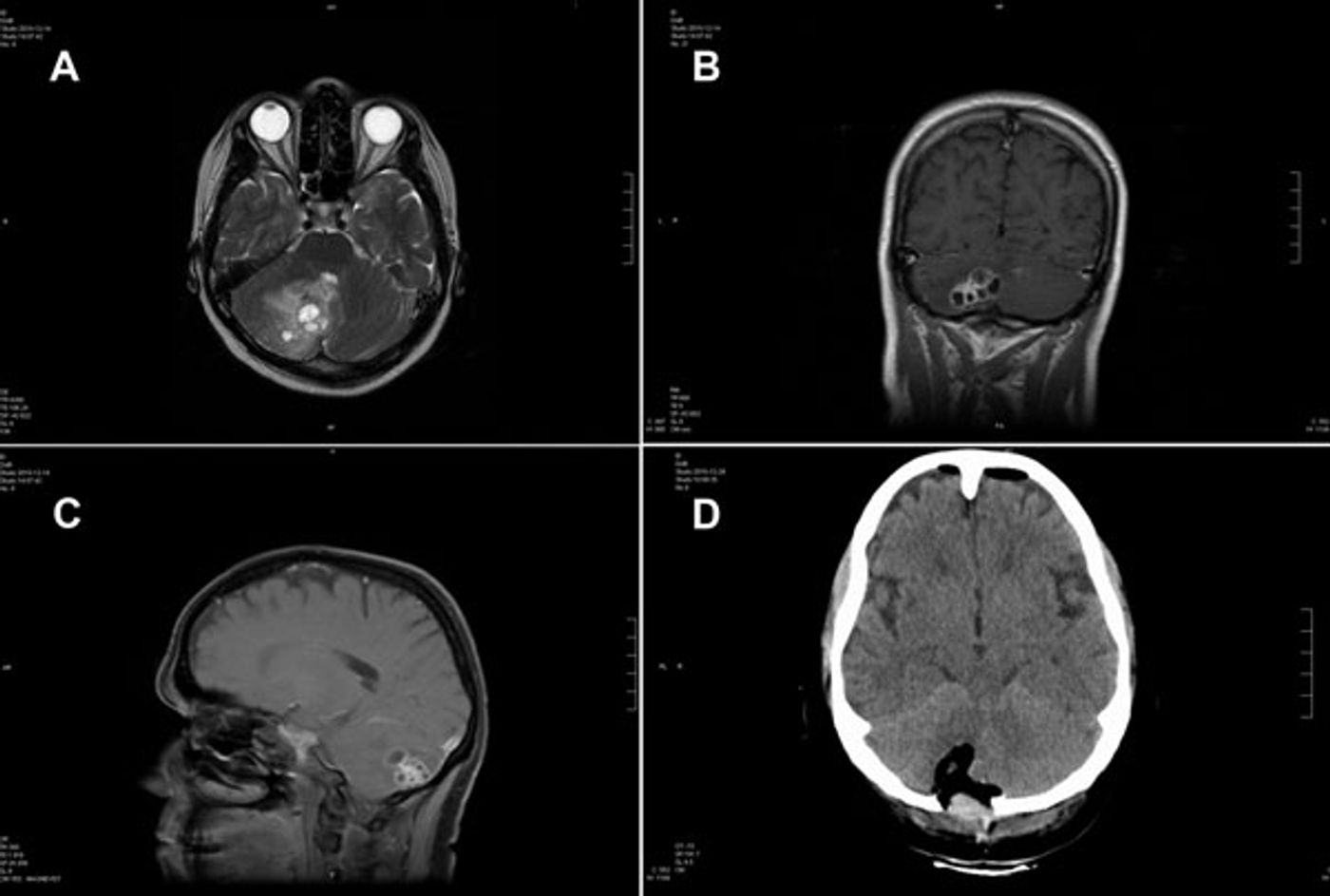Surgery Reveals That Supposed Brain Tumor is a Parasite
A New York woman began having terrible nightmares, hallucinations, and insomnia, and then she started to drop things. She was making strange phone calls she didn’t remember and forgetting where she was. Visits to urgent care did not reveal the cause, and an MRI was eventually done; it revealed a lesion adjacent to an area of the brain controlling speech. Doctors thought she had a malignant tumor and scheduled surgery.
Magnetic resonance (MR) and computed tomographic images of Taenia crassiceps tapeworm larvae infection in the brain. A) Transverse view - A parasitic lesion with perifocal edema is in the right hemisphere of the cerebellum; it caused ataxia, headache, and nausea. B) Coronal view - The cyst-like appearance of the parasitic tissue is clearly visible. This lesion can be misinterpreted. C) Sagittal view D) Transverse view, after surgery / Credit: CDC / Vasileios Ntoukas, Dennis Tappe, Daniel Pfütze, Michaela Simon, and Thomas Holzmann
Dr. Raj Shrivastava was a member of the Mount Sinai Hospital neurosurgical team that was tasked with the operation. He and the team opened her skull, expecting a typical brain tumor that would be soft and spread out. But they saw something else that was encapsulated and firm, and they removed it in one piece. Once it was out, they cut into it.
“Sure enough, a baby tapeworm came out of that lesion,” said Dr. Jonathan Rasouli, the chief neurosurgery resident at the Icahn School of Medicine at Mount Sinai in New York City and another surgical team member.
This is one case where the parasite was the preferable diagnosis. “She had a single parasite in her head that we were able to take out. We were very happy; it was one of those rare situations where you see a parasite and you’re like, wow this is great!”
This kind of parasitic infection, cysticercosis, is relatively rare in the United States and was not considered when the doctors were making their original diagnosis; it doesn’t happen like many foodborne illnesses that are caused by bacterial pathogens, and is not caused by eating undercooked pork.
Instead, a person first has to have an intestinal tapeworm, which sheds eggs that end up in their feces. The eggs - larval cysts - can infect tissues, like muscles or the brain. So if feces from a person with a tapeworm contaminates food that gets eaten, then cysticercosis - the parasitic tissue infection - develops. Therefore the disease is far likelier to happen to members of a household in which someone is carrying a tapeworm than to members of households without a tapeworm case. Undercooked pork can, however, cause a tapeworm if larval cysts are in the meat.
Tapeworm and cysticercosis happen to people around the world. Rates are highest in areas with poor sanitation practices and pigs that range freely. While it’s more common in Asia, Africa, and Latin America, it can also happen in North America when people don’t use good handwashing practices.
The Centers for Disease Control and Prevention (CDC) has targeted cysticercosis for “public health action” and considers it a neglected parasitic infection. They want to improve diagnostics and increase awareness of the illness, among other goals.


![[Guide] 7 Strategies to Boost Laboratory Collaboration](https://d3bkbkx82g74b8.cloudfront.net/eyJidWNrZXQiOiJsYWJyb290cy1pbWFnZXMiLCJrZXkiOiJjb250ZW50X2FydGljbGVfcHJvZmlsZV9pbWFnZV83YzBjZWIwM2Y5YzI4MmFlYzBhZDZhMTcyNTQ1ZGU3YmE4Y2MzMDYyXzUxNDkuanBnIiwiZWRpdHMiOnsidG9Gb3JtYXQiOiJqcGciLCJyZXNpemUiOnsid2lkdGgiOjcwMCwiaGVpZ2h0IjozNTAsImZpdCI6ImNvdmVyIiwicG9zaXRpb24iOiJjZW50ZXIiLCJiYWNrZ3JvdW5kIjoiI2ZmZiJ9LCJmbGF0dGVuIjp7ImJhY2tncm91bmQiOiIjZmZmIn19fQ==)






